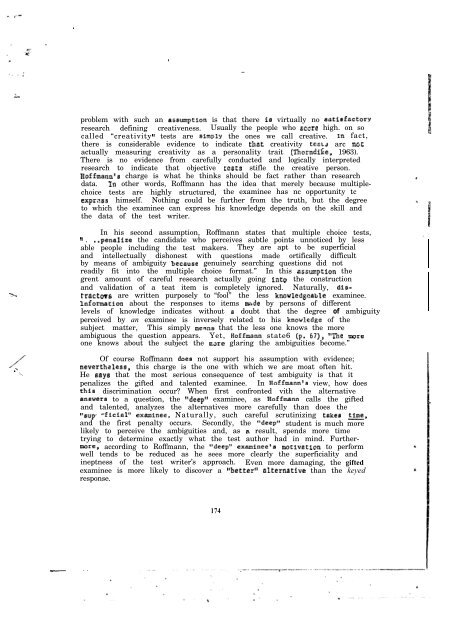Technical Report - International Military Testing Association
Technical Report - International Military Testing Association
Technical Report - International Military Testing Association
Create successful ePaper yourself
Turn your PDF publications into a flip-book with our unique Google optimized e-Paper software.
.-<br />
/ .‘4 ‘._.<br />
.<br />
- --<br />
.<br />
problem with such an ammption is that there lo virtually no sotieftctory<br />
research defining creativeness. Usually the people who sccre high. on so<br />
called “creativityI’ tests are aimply the ones we call creative. In fact,<br />
there is considerable evidence to indicate that creativity teal& arc not<br />
actually measuring creativity as a personality trait (Thorndike, 1963).<br />
There is no evidence from carefully conducted and logically interpreted<br />
research to indicate that objective tests stifle the creative person.<br />
Roffmsnn’s charge is what he thinks should be fact rather than research<br />
data. In other words, Roffmann has the idea that merely because multiplechoice<br />
tests are highly structured, the examinee has nc opportunity tc<br />
expr.?ss himself. Nothing could be further from the truth, but the degree<br />
to which the examinee can express his knowledge depends on the skill and<br />
the data of the test writer.<br />
In his second assumption, Roffmann states that multiple choice tests,<br />
,I . ..penalize the candidate who perceives subtle points unnoticed by less<br />
able people including the test makers. They are apt to be superficial<br />
and intellectually dishonest with questions made ortifically difficult<br />
by means of ambiguity becnuse genuinely searching questions did not<br />
readily fit into the multiple choice format.” In this assmption the<br />
grent amount of careful research actually going into the construction<br />
and validation of a teat item is completely ignored. Naturally, dierractors<br />
are written purposely to “fool” the less knovledgoa’ble examinee.<br />
information about the responses to items m*de by persons of different<br />
levels of knowledge indicates without n doubt that the degree of ambiguity<br />
perceived by an examinee is inversely related to his knowLedge of the<br />
subject matter, This simply menns that the less one knows the more<br />
ambiguous the question appears. Yet, Hoffmann state6 (p. 67), The more<br />
one knows about the subject the uarc glaring the ambiguities become.”<br />
Of course Roffmann doea not support his assumption with evidence;<br />
nevertheless, this charge is the one with which we are moat often hit.<br />
He saye that the most serious consequence of test ambiguity is that it<br />
penalizes the gifted and talented examinee. In Hoffmann’ view, how does<br />
this discrimination occur? When first confronted vith the alternative<br />
answera to a question, the “deep” examinee, as Hoffmann calls the gifted<br />
and talented, analyzes the alternatives more carefully than does the<br />
*‘sup’ -ficial” exsminee. Naturally, such careful scrutinizing takes tfme,<br />
and the first penalty occurs.<br />
Secondly, the “deep” student is much more<br />
likely to perceive the ambiguities and, as a result, spends more time<br />
trying to determine exactly what the test author had in mind. Furthermore,<br />
according to Roffmann, the “deep” examinee’s motlvetion to perform<br />
well tends to be reduced as he sees more clearly the superficiality and<br />
ineptness of the test writer’s approach. Even more damaging, the gifted<br />
examinee is more likely to discover a “better” al.ternative than the keyed<br />
response.<br />
174<br />
.









